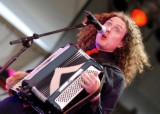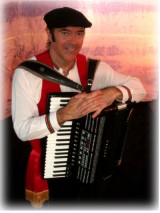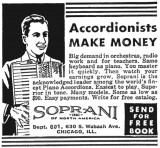Featured Stories
In Defense of the Accordion

Myron Floren from The Lawrence Welk Show

Weird Al Yankovich

Local accordion virtuoso Lou Fanucchi

Historically, the accordion is a kind of musical punch line. It symbolizes everything that is cheesy and corny for nearly a century — from your great grandmother’s music through Bobby Vinton to ironic, post-ironic, or meta-ironic Weird Al Yankovic and beyond. But the accordion is really only as good or as bad as the people where are playing it.
Surely, in some way most of us have the impression of the accordion as the instrument where the old guy at a restaurant with Chianti bottles on the wall plays “O Sole Mio” while we sit at a naugahyde booth. For those of us who grew up in San Diego, we can picture a genial, avuncular 70-year-old man accompanying local restaurateur (and minority San Diego Chargers owner) George Pernicano on the piano. Good times. It’s the sound of nostalgia of a passé version of showbiz that never quite existed; think back to the soundtrack of Woody Allen’s “Broadway Danny Rose” for a textbook example. In the general culture, accordion is the sound of polka. It’s the sound of squares, to people who felt or still feel that the word “square” is a putdown. It’s the unofficial instrument of Ed Sullivan-era talent contests and by the time I was growing up, was played out as a kitsch cliché on “The Gong Show” (yes, Rip Taylor, we get it: the accordion is lame). But there really is a lot more range to the instrument.
French music is riddled with it; Maurice Chevalier and Charles Aznavour might not have had a career without an accordion player by their sides. Zydeco music has on the accordion at the center of its sound. Tejano music is dominated by it (think Esteban “Steve” Jordan), as is its more obnoxious cousin, Ranchera music (albeit with a battery of trumpets). In Klezmer bands, the accordion player is usually second ranking behind the clarinet. Gotan Project uses more atmospheric accordion to create a really trippy lounge genre of their own. It’s been a part of traditional and modern Irish music from the Dubliners through the indelible Pogues punkish accordion (and continued by the destitute man’s Pogues, the Dropkick Murphys).
In rock, the accordion has helped define the bands in one of the most vibrant current genres of “Gypsy Punk” or Eastern European-sounding popular music, such as Devotchka and Gogol Bordello. “Squeeze Box” is oddly one of The Who’s most accessible and crowd-pleasing songs. Los Lobos’ signature sound comes from the accordion (and co-lead singer David Hidalgo is one of the few guys who makes the full-size version of the instrument look puny). Brian Jones’ playing on the Rolling Stones “Backstreet Girl” can be heartbreaking. My hero, Bruce Hornsby, trots it out during shows and even introduced it to Deadheads when he’s sat in with the Grateful Dead in the ’90s. Accordions play key parts of Bruce Springsteen’s “Sandy” and Bill Joel’s “Scenes from an Italian Restaurant.” Check out John Mellencamp’s “Jackie Brown” and acoustic “Small Town,” They Might Be Giants’ “Birdhouse in Your Soul” and REM’s “You Are the Everything” to run the range, from sentimental to silly to moving. More than anyone Arcade Fire is restoring some pride to the instrument without a trace of irony.
Nobody was defined by the accordion as much as Lawrence Welk, for better or worse. I’m going to refrain from saying much about the Welk show and its musical family (the second most notorious American pop-culture family to the “Manson family”) in this article and save it for another one here in this space in the future. But let me just say that it’s easy to laugh at Myron Floren (Welk’s aide-de-camp) while he’s wearing a tangerine colored leisure suit in “The Lawrence Welk Show” repeats on PBS; watch him play once in a while. He is a accordion playing mofo; he is to the squeeze box what “Johnny” is to the fiddle in “The Devil Went Down to Georgia.” And the Welk accordion tradition continued into the 1980s with heir apparent Joey Schmidt. By the way, Lawrence Welk Ground Zero is located just up the road here in Escondido. Although this article isn’t really about kitsch, if it’s musical cheese you want to pay homage to, you should really take a pilgrimage to Lawrence Welk HQ here.
San Diego has some solid accordion players. Lou Fanucchi is probably the dean of local accordion players; Gordon Kohl also comes to mind. I grew up here in San Diego and I must admit that the accordion became somewhat of an instrument of terror for me when my grandmother would take me to Balboa Park on Sundays to watch pseudo-ethnic groups play their country’s music at the corny Houses of Pacific Relations. Somehow the afternoon free coffee and pastry crowd on Sundays tended to skew towards Eastern Europe; funny how at the “Pacific Relations” area, about 80% of the music involved an accordion.
By far, my favorite local San Diego accordion experience was at a local show of “sex workers” (prostitutes, strippers, phone sex operators) doing various performances at a really cool underground art spot at an odd space in Ocean Beach about 10 years ago. There were a few energetic but hackneyed monologues, some great things… but what blew the doors off the place was a heavy gal who got up with an accordion. (Unless my memory is faulty, I believe her name was Nomy Lamb and she is/was a phone sex operator and a very solid monologist.) She owned the stage in a way like Jack Black does on his best nights; her energy and commitment to what she was doing far outweighed the obvious ironic inanity of what we were all supposed to think of the accordion. Her opening chords drew the loudest air out of the bellows I have ever heard on the box. Let me remind you that she was a strong, big gal. She played a simple 1-4-5 progression then let fly with the words, “Oh, you better take me home tonight…” which knocked me off balance like a left jab at first. Yes, I was the only straight male in a packed audience in a sweaty condemned house in Ocean Beach watching a chunky sex worker sing Queen’s “Fat Bottomed Girls.” I wish I could accurately describe how much she absolutely sold the bejesus out of that song. Picture the most scenery-chewing diva killing it in your living room, all on an accordion, and that’s something close to what I was getting that night. If anybody know how to reach her upon reading this, I’d like her to know that it’s possibly the best single performance I’ve ever seen.
Personally, I think the bar is pretty high for the greatest accordionists. Thankfully for me, the public perception still exists of the accordion as pure schlock, which makes it easier when I’ve been trying to use the accordion when playing locally. Just this past month I accompanied this issue’s poster boy, Michael Tiernan, on accordion at Anthology and The Belly Up. I trot it out for shows with my band, The Bigfellas. And whenever my friend and local fave Spud Davenport gives me the call, I’ll show up to fumble and squeeze my way through one or two of his originals on the accordion.
In my case, when playing at a local San Diego location, I don’t really have to play great. It’s just the novelty of an accordion being there is what’s center stage at those moments. It’s like when there’s a celebrity cameo on “Saturday Night Live” — it brings a roar from the crowd initially, but then within 90 seconds the sketch has run out of steam and it’s time to move on. Used sparingly, the accordion is terrific in those situations. Nobody wants a two-hour accordion show. But for a little flavor on the right song, there’s nothing better.
I do have ambitions for the accordion. So far, my band has used it on recordings — if anybody’s scoring at home — in The Bigfellas “4:20” as a low rumble, in “Vous Ne Parlez Francais” (aka to us only as “the Frenchy song”), and in the dopey ELO cover “Mr. Blue Sky.” It’s amazing how a mic’ed accordion put low in the mix does magic as a wall of sound element. But I do want to get a little more proficient on it, instead of being a one-note joke.
The accordion may sound simple and silly. Don’t let it fool you, it’s the toughest instrument I play. The right hand is fine; first month piano students can handle that part. And the squeezing doesn’t take long to get used to. It’s just those insane buttons on the left hand. For you music theorists out there, the buttons are laid out in circles of fifths order: Db — Ab — Eb — Bb — F — C — G — D — A — E, etc. That’s just one row. There’s a row of octaves (that’s my home base). There’s a row of all full, three-part major chords. Another row of full minor chords. And there’s two more rows of god knows what — diminished chords? I never let my fingers touch that.
If you’ve ever been less than five feet away from a quality accordion, you’ll notice it’s a loud and powerful instrument. Putting it all together blind, while facing an audience, is a challenge. But one that I will choose to accept! If I get there, I hope to write some genuine music with it — to play with half the command of Myron Floren, or the inventiveness of Bruce Hornsby or Arcade Fire. Or at the very least, I can put together a credible mashup of “In A Gadda Da Vida” and “Hava Nagila.” Dammit, “In a Hava Nagila” is something Weird Al should have done — I have to think that one over. Yes, with great power comes great responsibility.
Charlie Recksieck writes, plays, and sings with the Bigfellas (www.bigfellas.net) and tweets about minor inconveniences at www.twitter.com/thebigfellas






